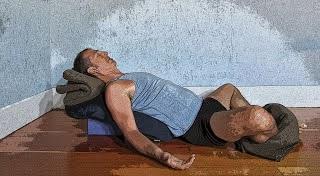 Just a quick announcement today about some research findings I think you’ll all enjoy hearing about. Baxter and I read about a recent study, designed by Maria G. Araneta, PhD, MPH, of the University of California, San Diego, to determine whether obese women would see a loss of fat from less intense exercise instead of aerobic activity. Although not a huge study, the group sizes were larger than most of those we see in recent studies, with the yoga group of 88 having a mean age of 55 years with an average BMI of 36 kg/m2 and the stretch group of 83 having a mean age of 54 years with an average BMI of 32.5 kg/m2.
Just a quick announcement today about some research findings I think you’ll all enjoy hearing about. Baxter and I read about a recent study, designed by Maria G. Araneta, PhD, MPH, of the University of California, San Diego, to determine whether obese women would see a loss of fat from less intense exercise instead of aerobic activity. Although not a huge study, the group sizes were larger than most of those we see in recent studies, with the yoga group of 88 having a mean age of 55 years with an average BMI of 36 kg/m2 and the stretch group of 83 having a mean age of 54 years with an average BMI of 32.5 kg/m2.Along with her co-authors Matthew A. Allison, MD, MPH, Elizabeth Barrett-Connor, MD, and Alka M. Kanaya, MD, Dr. Araneta presented the results at the 73rd Scientific Sessions of the American Diabetes Association in Chicago (June 21-25). And their findings showed that the restorative yoga practitioners lost significantly more subcutaneous fat over the initial six months of the study period, and kept losing it during a maintenance period with less direct supervision! This is important because all the women participating in study had metabolic syndrome, which the Mayo Clinic defines as:
Metabolic syndrome is a cluster of conditions — increased blood pressure, a high blood sugar level, excess body fat around the waist and abnormal cholesterol levels — that occur together, increasing your risk of heart disease, stroke and diabetes.
Metabolic syndrome affects 44% of the U.S. population older than age 50. And reducing abdominal fat may help reverse the syndrome.
Although the team is still reviewing the data, they’ve speculated that one explanation for the difference between the effects found with restorative yoga and stretching may be that restorative yoga reduces levels of cortisol. As Timothy wrote in his background post Stress, Your Health and Yoga, cortisol levels rise during times of stress and is known to increase abdominal fat. And in Baxter’s post Cortisol and Good Health Baxter wrote about the dangers of prolonged periods of stress and high levels of cortisol. I wrote specifically about the relationship between stress, cortisol and weight management in my post Yoga, Stress and Weight Management. So we'll be very interested to see the follow-up studies.
In Baxter's post on cortisol, he actually recommended restorative yoga along with yoga nidra as stress reduction—and cortisol-lowering—solutions. However, meditation (see Starting a Meditation Practice) and supported inversion poses (see All About Supported Inverted Poses) are also helpful. For a complete overview of how to use yoga to switch your nervous system from the Stress Response (Fight or Flight) to the Relaxation Response (Rest and Digest), see The Relaxation Response and Yoga.
In her presentation, Dr. Araneta did not recommend restorative yoga as a replacement for aerobic activity; instead, she said this “complementary” practice could provide a means of gentle movement for those severely obese patients for whom other activity is not practical. But as I wrote in Restorative Yoga: An Introduction, restorative yoga is a complementary practice that benefits all of us.
If you haven't already, check out Baxter's video of the classic restorative pose, Reclined Cobbler's pose!

